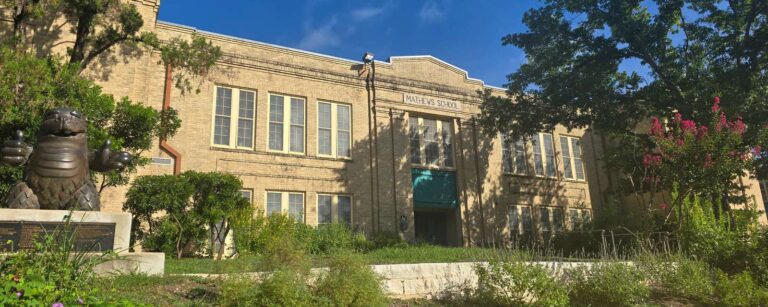Old West Austin History
Historic Documents about Old West Austin
- 1973 Statesman article on the Smoot Home
- 1969 UT School of Architecture pamphlet on Clarksville
- 2024 Haskell House Documentary
The Old West Austin neighborhood is bounded by Mopac Expressway on the west, Enfield Road on the north, Lamar Boulevard on the east, and Town Lake on the south. This neighborhood exemplifies the diverse people that built Austin. The area contains a rich set of historical elements ranging from residential properties to community service sites and businesses, which demonstrate a clear picture of Austin from the late 1800s. One integral component of this diverse neighborhood, Clarksville, has already been recognized as a National Register Historic District.
In 1876 the International and Great Northern Railroad came to Austin. In 1956 it became the Missouri and Pacific Railroad and its tracks, which traverse the Old West Austin area across its southern edge, are still in use today by Amtrak passenger trains and by cargo trains. The Amtrak depot is located within the neighborhood boundaries at 250 N. Lamar Boulevard. In its past, the railroad offered the people of Austin links to cities such as Chicago, Louisville, Washington, DC, and New York. The International and Great Northern Railroad provided all the “modern” improvements of the time, such as Pullman Sleeper cars and travel “without change of cars.”
If one was not traveling, the social centers of Austin often were the beer gardens. Paul Pressler owned one of the first of the famous beer gardens. In operation prior to 1897, Pressler Beer Garden was located near where present day West 6th Street and Pressler Street meet. Built in connection with the Pressler Brewery, it boasted a bandstand and shade trees, and stretched all the way to the river.
Near present day 3rd Street and Lamar Boulevard is Tips Iron and Steel Company. It was founded in 1899 and moved to its current location in 1909. For many years Tips supplied engines, gas meter covers, and structural support beams for downtown buildings such as the Driskill Hotel and the city library at 9th and Guadalupe (now the Austin History Center). Allan Perry, a descendant of early neighborhood families, recalls that Elton Perry, Sr., great-grandfather to Allan and original owner of the Perry House at 610 Baylor Street, made the forms for many of these items produced at Tips Iron and Steel Company. Elton Perry, Sr. was also the father/father-in-law of the original owners of the Taylor House (a designated Austin Landmark) at 608 Baylor Street. The Taylor House remains in the Taylor family to this day.
In 1889, the Texas Confederate Home for Men was established where the present day University Housing is located on West 6th Street. After the Civil War, the Union Soldiers were provided pensions and care, but the Confederate Soldiers were left to fend for themselves. Through a large community effort, the John B. Hood Camp of Veterans, in conjunction with the Albert Sidney Johnston Chapter of the Daughters of the Confederacy, raised funds that enabled them to build several brick cottages for Confederate soldiers. Capt. Ben McCullough was superintendent of the home around 1912 and lived there with his wife, who was the widow of R.C. Barton. Mrs. McCullough’s granddaughter remembers visiting the home and being fascinated by the wires that existed between the dining room and the cabins. These wires allowed the blind veterans to hook their walking canes on them and safely navigate around the grounds. In 1920, Hobby Memorial Hospital was completed and with dwindling numbers of veterans in residence, the 48th Legislature decided that it was appropriate to transfer mental patients to the Confederate Home. The Home was demolished in 1970, but residents of the Clarksville area still remember the home.
Charles Clark, a freed slave, purchased two acres of land in 1871 from Nathan Shelley, a Confederate general. This land became the center of the Clarksville community, one of the first freedman’s towns established west of the Mississippi and one of the oldest continuously cohesive neighborhoods in Austin. The Sweet Home Missionary Baptist Church was established soon after Clarksville was founded. Sweet Home built their first church building in 1882. The present home of the church was built in 1935. Clarksville was listed as a National Register Historic District in 1976. The Clarksville Community Development Corporation (CCDC) website has a detailed history of the origins of Clarksville.
In addition to the many buildings of historic interest in the area, described above, other features of the neighborhood provide insights into the past life of the residents of the area.
West Austin Park was the original site of the Clarksville Jazz Festival (now held in Pease Park). The park has long been a place for the residents of the neighborhood to swim or enjoy a nice day in the park.
A Moonlight Tower, one of the 17 remaining in Austin, still stands at the corner of 12th Street and Blanco Street. The towers have been in operation for over 100 years. They have only been turned off three times since their original installation. Once in 1905 the towers were off for a week due to a dispute between the city council and the water and light commission. The second time the towers were darkened was in 1973 during the energy crisis. The Moonlight Towers were completely restored in the mid 1990s by the City of Austin.
Austin Landmarks in the Neighborhood
There are many designated Austin Landmarks within the boundaries of the Old West Austin neighborhood. These include:
